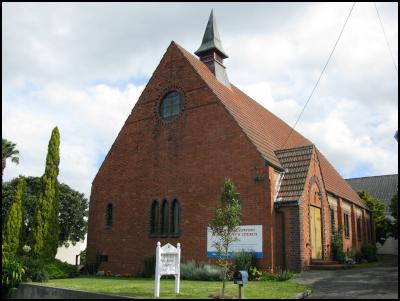St Augustine’s Church registered

St Augustine’s Church in Devonport.
Thursday April 17
MEDIA RELEASE
St Augustine’s Church registered
The historic importance of a Devonport church has been recognised by the country’s lead heritage agency.
St Augustine’s Church was registered last year as a Category 2 historic place by Heritage New Zealand (formerly the NZ Historic Places Trust), in recognition of its historic significance.
“The registration is particularly significant for its close association with World War I as a memorial church. In light of the 100th anniversary of the beginning of the First World War later this year, it seems appropriate to reflect on its importance,” says Heritage New Zealand’s Registration Adviser, Martin Jones.
“It also ties in strongly with this year’s theme of Heritage and Commemoration as part of the International Day for Monuments and Sites on April 18 – a global celebration of heritage organised by ICOMOS [the International Council on Monuments and Sites].”
The original wooden church, now used as a hall on the St Augustine’s site, was dedicated only a few months before the declaration of the First World War – a conflict that was to have a significant impact on the parish.
“Anglicans in Auckland were said to have been particularly dutiful in upholding concepts of imperial patriotism and loyalty to the Crown, and the parish of St Augustine’s Church was no exception,” says Martin.
“A number of younger members of the congregation who worshipped at the church were killed during the war, including at Gallipoli, Ypres and the Somme – with similar losses experienced around the country.”
Some of those who died from St Augustine’s were from prominent Auckland families, such as Flight Sub-Lieutenant L.H. Brett – a grandson of Sir Henry Brett, founder of the Auckland Star and a Mayor of Auckland. Another who did not return, Private Willmet Philson, was one of 147 New Zealanders who tragically died on the first day of the landings at Anzac Cove (25 April 1915), since commemorated as Anzac Day.”
The idea of building a memorial church commemorating the lives of the local soldiers who never returned home was first mooted in 1919. When Stanley Bay became an independent parish in 1924, fundraising for the new church began with the intention of making the new building ‘very beautiful and dignified, fitting for its higher use and purpose’.
The current St Augustine’s Church was eventually constructed and completed in 1930.
The landmark brick building was designed by Auckland architect William Swanson Read Bloomfield – an appropriate choice.
“Bloomfield served in the Royal Flying Corps during the First World War and had been shot down behind enemy lines in 1917. He was also the brother-in-law of one of the local men commemorated by the church, Gunner R.L Gribbin,” says Martin.
“Bloomfield was of Ngati Kahungunu descent on his mother’s side and is notable as probably the first person of Maori descent to study at an architectural school and practice as an architect.”
The presence of the initials VAB on one of the early architectural drawings also suggests that Vernon Akitt Brown may have used some of his drafting skills for some of the work. Brown was to have an important influence on New Zealand architecture in subsequent years.
The new church building – with its distinctive Marseilles tile roof and bell turret – was built in the Arts and Crafts style, and was completed in 1930. The church is also characterised by the use of locally made Duder’s bricks, with ornamental detailing.
“The church had strong links to the Naval base, located close by, and use of the church hall was offered free of charge to the Navy League for its work with naval trainees during the Second World War,” says Martin.
“That link was strengthened further with the re-amalgamation of Stanley Bay with Devonport Parish in 1948. The naval chaplain – Rev Mayo-Harris – became parish priest in 1958 and his successor, Rev Dawson, had served as an army chaplain and had earned a Military Cross and mentions in despatches, reinforcing the military connection with the parish.”
In 1979, the church was leased out to the Royal New Zealand Navy for use as a naval chapel – an arrangement that lasted until the early 1990s. Today the church continues to be used regularly for services including christenings, weddings and funerals.
“St Augustine’s Church continues to make a valuable contribution to Devonport community life,” says Martin.
“It plays an important role in reflecting New Zealand’s involvement in the First World War, and the impact the conflict had on local communities. It also reflects the desire of these communities to remember their loss.”


 NZ Drug Foundation: Two New Studies Show A Concerning Increase In Drug Use And Availability
NZ Drug Foundation: Two New Studies Show A Concerning Increase In Drug Use And Availability Emirates Team NZ: Emirates Team New Zealand Ranked #5 In Global Sports Technology Power List
Emirates Team NZ: Emirates Team New Zealand Ranked #5 In Global Sports Technology Power List Tātaki Auckland Unlimited: Discover The Treasures Of Tāmaki Makaurau - Making Māori Tourism Accessible To All
Tātaki Auckland Unlimited: Discover The Treasures Of Tāmaki Makaurau - Making Māori Tourism Accessible To All International Writers' Workshop NZ Inc: Ōtepoti Poets Top The Kathleen Grattan Prize For A Sequence Of Poems
International Writers' Workshop NZ Inc: Ōtepoti Poets Top The Kathleen Grattan Prize For A Sequence Of Poems NZ Amateur Sport Association: 22 Amendments Proposed For 2022 Act Lodged On 22 November
NZ Amateur Sport Association: 22 Amendments Proposed For 2022 Act Lodged On 22 November Auckland University of Technology: Reading Helps Children Face A Difficult Future
Auckland University of Technology: Reading Helps Children Face A Difficult Future